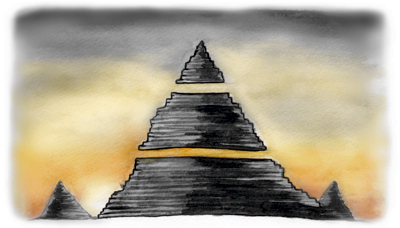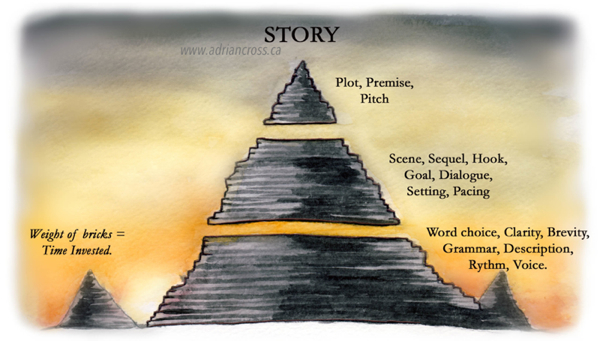
Aside from being an effective paperweight, what does a pyramid have to do with writing a novel?
The answer is both simple and complicated, and not something well communicated to new writers. The pyramid represents the different layers of technique to be learned with writing. They’re not all the same. There’s different types of bricks that need to be heaved up, for different uses. You can be a master at one and a disaster at another.
Before I start explaining, let me give credit where credit is due: this concept was inspired by a couple of lines in the enlightening book ‘Don’t Sabotage Your Submission’ by Chris Roerden. Originally a book written for mystery writers, it won the Agatha Christie award and was later revised for genre writing more broadly.
So now that I’ve given credit, and built up your anticipation to a fever pitch, what is this simple but powerful concept? Ms. Roerden makes the simple but elegant point that there are actually three layers to writing skills, which require different skill sets and resources to address. I would also add that the different layers also involve different amounts of time and effort, making the pyramid an apt metaphor.
This is the simple graphic that represents the pyramid: (FYI, I believe my categories vary slightly from Ms. Roerden’s, but the general concept is the same. Again, feel free to buy her book and compare):
There are books dedicated to the top of the pyramid (how to plot and outline or revise on a very big picture level, such as screenwriting classic Save the Cat, by Blake Snyder), and books on the bottom (how to manage grammar and word choice, the classic being Elements of Style, by Strunk and White), but Ms. Roerden makes the very wise point that most agents and editors reject submissions based on the middle layer, which isn’t nearly as well covered in the forest of writing craft books. I would agree, and that is what makes her book so helpful, especially as it applies to the first chapter, where most agents and editors reject submissions.
But while Ms. Roerden noted this point, and moved on, I think that it’s worth stopping and dwelling on the concept of the writing pyramid for a second.
While I obviously won’t get into the minute detail of each layer (there are full books on each, as noted, which means that that would make a very long post), I thought it might still be helpful to give some broad examples, to help clarify the layers, particularly as they apply to submissions for agents or editors. So here we go:
The Peak of the Pyramid: Story Premise and Structure. The Big Picture.
Does your pitch promise an exciting story, start to finish? Do you have a Raiders of the Arc storyline, with Harrison Ford lighting up the pages? The peak of the pyramid is the quick pitch, the big picture of character and plot, what the back of the book promises. A cranky professor and relic-hunter tries to rescue an old flame and prevent the destruction of the world, by tracking down an ancient artifact while pursued by World War II Nazis. Sounds good to me!
If your original story package isn’t strong, you might have the most smoothly crafted, lyrical writing in the world, and most agents aren’t going to care. Your baby is going to be tossed into the rejection bin (or they’ll hit the auto-reject and delete buttons, to be completely accurate).
I know, ouch, but… isn’t it better to know? And improve?
The Base of the Pyramid: Picking the Right Words.
On the other end of the spectrum, you might have a decent story premise, but if your English is weak, your words misspelled, and you flip between spelling ‘Indy’ and ‘Indie’ every second line, because you didn’t proof read your work… well, that poor editor’s assistant is going to think about how much work it’s going to be to edit your manuscript and…
Delete again. Maybe not as quickly as if you had a dud of a story idea, but you’re still digging yourself out of a hole. My guess is that most editors won’t go the extra mile in this situation. Why not? Mostly because of all the times I’ve heard agents coo about how much they want to discover a fresh new voice, one that grabs them from the first word and doesn’t let go.
You know what’s a major part of voice?
You got it. Word choice. If you can’t do that, those agents aren’t cooing about you.
The Middle of the Pyramid: Scenes, Tension, and Turning the Pages:
Ms. Roerden’s point is well taken. This is where most mid-level writers go wrong, where they get a form reject, and don’t know why, after reading all the books above, pruning their language, and bouncing their work off critique partners. This is where the high-potential writers start to separate themselves, by catching the editor’s attention, building tension, keeping the scene moving. By not letting the editor hit the delete key. Indeed, by making them want to read more.
Easily described. Not so easily accomplished. Trust me, I realize. But knowing what you don’t know is half the battle, for the dedicated and talented out there, who have the potential to succeed, given the chance.
But more specifically, what kind of stuff does this entail?
“Indiana Jones scratched his beard in front of the class, squinting as soft sunlight reflected from burnished wood desktops, slightly warm and bubbled, reminding Indiana of the long bath he’d had that morning, with scented carmine bubble bath. It was a long drive to the University and the cold wind of the changing season played havoc with his knees. As he’d been soaking, his thoughts had drifted back to his first professor, a grey-bearded man who had once…”
Um, did I lose you? I might have glazed over myself. I’m working hard at establishing setting, character, a bit of backstory. And I haven’t hooked anybody to keep reading. My great pitch paragraph will only keep an editor reading so long before they conclude that, again, it’s too much work to teach me these intermediate mechanics, and she’s better off not taking the chance.
So what does it all mean?
I don’t mean this post to be depressing, but I think that there’s a couple of important things for a new writer to take from this post, from the pyramid way of looking at things. First, writing is more than one skill set, just like playing soccer is more than just running fast, or golf learning the perfect grip. To be top of the heap, to get published, you have to hit your stride on all three levels of the pyramid. And, to repeat Chris’s point, they require different writing books for each. So don’t focus on one layer to the exclusion of the others.
Another take away, and something I find quite frustrating myself, is the huge variance in time invested for the different levels. The peak of the pyramid doesn’t take much time, relatively, even if it’s a week or month to plot out your book. That’s only a small fraction of the time to finish the scene and sentence level work following. But…
If your story premise and opening suck, no-one will ever read it. No-one. Except your Mom. (PS, Aren’t Mom’s great?)
Uplifting thought, isn’t it?
Cold comfort it may be, but it’s not time wasted. The lower levels of the pyramid are important too, and those skills need to be polished. But still, don’t waste years of your life trying to perfect sentence level issues, when it’s your premise appeal that’s the problem. Not unless you don’t care about commercial success.
That’s not me.
So there you go. Research. Practice. Hit your stride on all levels. Be a master bricklayer, from top to bottom.
Just don’t drop any on your toes. That hurts.
The image here is another quick project. I had originally planned on the feature image being another painting, a little dragon that I’ve been working on the last few weeks, and is nearly done. But then I realized that the dragon had absolutely no relation to the topic, and there was no reason to delay this craft post any longer. But you should be seeing the dragon soon. Because this site definitely WILL have dragons… 🙂

Thanks for sharing your thoughts about search.
Regards
These are awesome! Look at you ron12cik7; Kodak Gold! I am completely smitten with the grain in your HP5 images. I loved the little peek into your beautiful family through film. Can’t wait till next month!